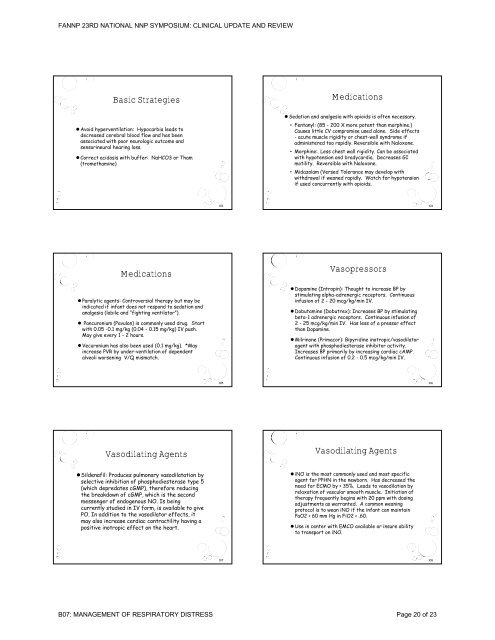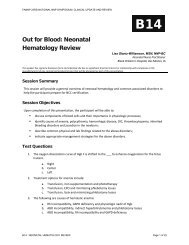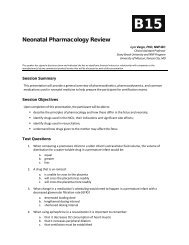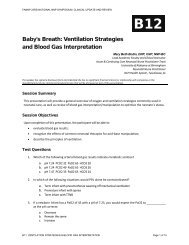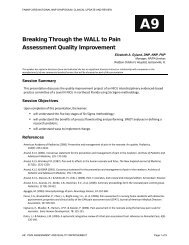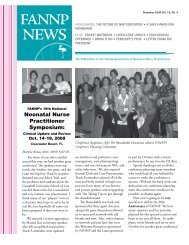Differential Diagnosis and Management of Respiratory ... - FANNP
Differential Diagnosis and Management of Respiratory ... - FANNP
Differential Diagnosis and Management of Respiratory ... - FANNP
You also want an ePaper? Increase the reach of your titles
YUMPU automatically turns print PDFs into web optimized ePapers that Google loves.
<strong>FANNP</strong> 23RD NATIONAL NNP SYMPOSIUM: CLINICAL UPDATE AND REVIEW<br />
Basic Strategies<br />
Medications<br />
• Avoid hyperventilation: Hypocarbia leads to<br />
decreased cerebral blood flow <strong>and</strong> has been<br />
associated with poor neurologic outcome <strong>and</strong><br />
sensorineural hearing loss.<br />
• Correct acidosis with buffer: NaHCO3 or Tham<br />
(tromethamine)<br />
• Sedation <strong>and</strong> analgesia with opioids is <strong>of</strong>ten necessary.<br />
• Fentanyl: (85 - 200 X more potent than morphine.)<br />
Causes little CV compromise used alone. Side effects<br />
- acute muscle rigidity or chest-wall syndrome if<br />
administered too rapidly. Reversible with Naloxone.<br />
• Morphine:. Less chest wall rigidity. Can be associated<br />
with hypotension <strong>and</strong> bradycardia. Decreases GI<br />
motility. Reversible with Naloxone.<br />
• Midazolam (Versed Tolerance may develop with<br />
withdrawal if weaned rapidly. Watch for hypotension<br />
if used concurrently with opioids.<br />
103<br />
104<br />
Medications<br />
• Paralytic agents: Controversial therapy but may be<br />
indicated if infant does not respond to sedation <strong>and</strong><br />
analgesia (labile <strong>and</strong> “fighting ventilator”).<br />
• Pancuronium (Pavulon) is commonly used drug. Start<br />
with 0.05 -0.1 mg/kg (0.04 - 0.15 mg/kg) IV push.<br />
May give every 1 - 2 hours.<br />
• Vecuronium has also been used (0.1 mg/kg). *May<br />
increase PVR by under-ventilation <strong>of</strong> dependent<br />
alveoli worsening V/Q mismatch.<br />
Vasopressors<br />
• Dopamine (Intropin): Thought to increase BP by<br />
stimulating alpha-adrenergic receptors. Continuous<br />
infusion <strong>of</strong> 2 - 20 mcg/kg/min IV.<br />
• Dobutamine (Dobutrex): Increases BP by stimulating<br />
beta-1 adrenergic receptors. Continuous infusion <strong>of</strong><br />
2 - 25 mcg/kg/min IV. Has less <strong>of</strong> a pressor effect<br />
than Dopamine.<br />
• Milrinone (Primacor): Bipyridine inotropic/vasodilator<br />
agent with phosphodiesterase inhibitor activity.<br />
Increases BP primarily by increasing cardiac cAMP.<br />
Continuous infusion <strong>of</strong> 0.2 - 0.5 mcg/kg/min IV.<br />
105<br />
106<br />
Vasodilating Agents<br />
Vasodilating Agents<br />
•Sildenafil: Produces pulmonary vasodilatation by<br />
selective inhibition <strong>of</strong> phosphodiesterase type 5<br />
(which depredates cGMP), therefore reducing<br />
the breakdown <strong>of</strong> cGMP, which is the second<br />
messenger <strong>of</strong> endogenous NO. Is being<br />
currently studied in IV form, is available to give<br />
PO. In addition to the vasodilator effects, it<br />
may also increase cardiac contractility having a<br />
positive inotropic effect on the heart.<br />
• iNO is the most commonly used <strong>and</strong> most specific<br />
agent for PPHN in the newborn. Has decreased the<br />
need for ECMO by > 35%. Leads to vasodilation by<br />
relaxation <strong>of</strong> vascular smooth muscle. Initiation <strong>of</strong><br />
therapy frequently begins with 20 ppm with dosing<br />
adjustments as warranted. A common weaning<br />
protocol is to wean iNO if the infant can maintain<br />
PaO2 > 60 mm Hg in FiO2 < .60.<br />
• Use in center with EMCO available or insure ability<br />
to transport on iNO.<br />
107<br />
108<br />
B07: MANAGEMENT OF RESPIRATORY DISTRESS Page 20 <strong>of</strong> 23


